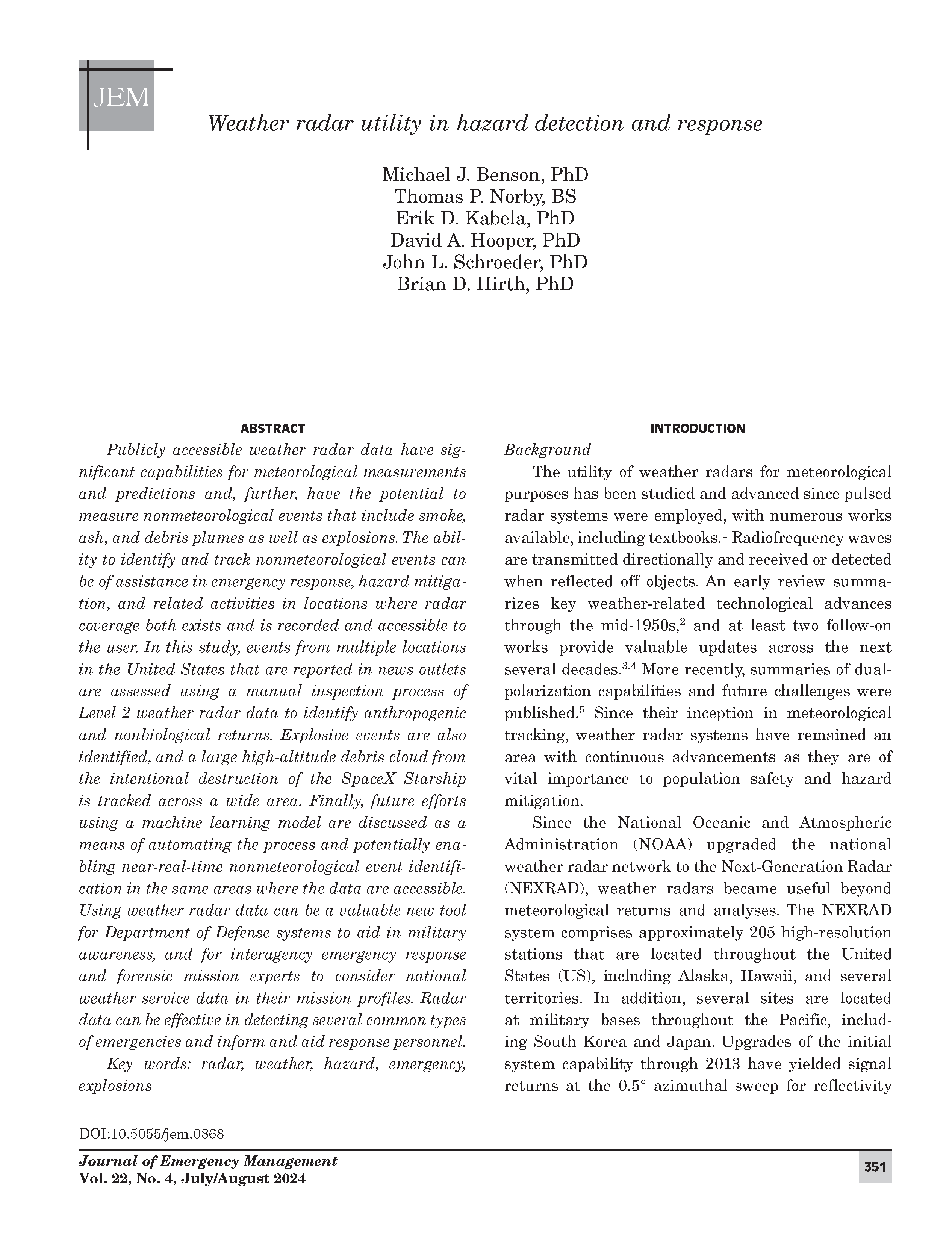Weather radar utility in hazard detection and response
DOI:
https://doi.org/10.5055/jem.0868Keywords:
radar, weather, hazard, emergency, explosionsAbstract
Publicly accessible weather radar data have significant capabilities for meteorological measurements and predictions and, further, have the potential to measure nonmeteorological events that include smoke, ash, and debris plumes as well as explosions. The ability to identify and track nonmeteorological events can be of assistance in emergency response, hazard mitigation, and related activities in locations where radar coverage both exists and is recorded and accessible to the user. In this study, events from multiple locations in the United States that are reported in news outlets are assessed using a manual inspection process of Level 2 weather radar data to identify anthropogenic and nonbiological returns. Explosive events are also identified, and a large high-altitude debris cloud from the intentional destruction of the SpaceX Starship is tracked across a wide area. Finally, future efforts using a machine learning model are discussed as a means of automating the process and potentially enabling near-real-time nonmeteorological event identification in the same areas where the data are accessible. Using weather radar data can be a valuable new tool for Department of Defense systems to aid in military awareness, and for interagency emergency response and forensic mission experts to consider national weather service data in their mission profiles. Radar data can be effective in detecting several common types of emergencies and inform and aid response personnel.
References
Page RM: The Origin of Radar. New York: Doubleday Anchor, 1962.
Marshall JS, Hitschfeld W, Gunn KLS: Advances in radar weather. Adv Geophys. 1955; 2: 1-56. DOI: https://doi.org/10.1016/S0065-2687(08)60310-6
Atlas D: Advances in radar meteorology. Adv Geophys. 1964; 5: 317-429. DOI: https://doi.org/10.1016/S0065-2687(08)60009-6
Atlas D: Radar in Meteorology. Berlin: Springer, 1990. DOI: 10.1007/978-1-935704-15-7. DOI: https://doi.org/10.1007/978-1-935704-15-7
Zhang G, Mahale VN, Putnam BJ, et al.: Current status and future challenges of weather radar polarimetry: Bridging the gap between radar meteorology/hydrology/engineering and numerical weather prediction. Adv Atmos Sci. 2019; 36(6): 571-588. DOI: 10.1007/s00376-019-8172-4. DOI: https://doi.org/10.1007/s00376-019-8172-4
Whiton RC, Smith PL, Bigler SG, et al.: History of operational use of weather radar by US Weather Services. Part II: Development of operational Doppler weather radars. Weather Forecast. 1998; 13(2): 244-252. DOI: 10.1175/1520-0434(1998)013<0244:Hoouow>2.0.co;2. DOI: https://doi.org/10.1175/1520-0434(1998)013<0244:HOOUOW>2.0.CO;2
Marzano FS, Marchiotto S, Textor C, et al.: Model-based weather radar remote sensing of explosive volcanic ash eruption. IEEE Trans Geosci Remote Sens. 2010; 48(10): 3591-3607. DOI: 10.1109/tgrs.2010.2047862. DOI: https://doi.org/10.1109/TGRS.2010.2047862
Schneider DJ, Hoblitt RP: Doppler weather radar observations of the 2009 eruption of Redoubt Volcano, Alaska. J Volcanol Geother Res. 2013; 259: 133-144. DOI: 10.1016/j.jvolgeores.2012.11.004. DOI: https://doi.org/10.1016/j.jvolgeores.2012.11.004
Montopoli M: Velocity profiles inside volcanic clouds from three-dimensional scanning microwave dual-polarization Doppler radars. JGR Atmos. 2016; 121(13): 7881-7900. DOI: 10.1002/2015jd023464. DOI: https://doi.org/10.1002/2015JD023464
Lareau NP, Donohoe A, Roberts M, et al.: Tracking wildfires with weather radars. JGR Atmos. 2022; 127(11). DOI: 10.1029/2021jd036158. DOI: https://doi.org/10.1029/2021JD036158
Kabela ED, Moss SC, Koch DB, et al.: Feasibility of Using Radar for Characterizing and Tracking Plumes. 2018. DOI: 10.2172/1436044. DOI: https://doi.org/10.2172/1436044
McCarthy N, Guyot A, Dowdy A, et al.: Wildfire and weather radar: A review. JGR Atmos. 2018; 124: 266-286. DOI: 10.1029/2018jd029285. DOI: https://doi.org/10.1029/2018JD029285
Helmus JJ, Collis SM: The python ARM radar toolkit (Py-ART), a library for working with weather radar data in the python programming language. J Open Res Soft. 2016; 4(1): 25. DOI: 10.5334/jors.119. DOI: https://doi.org/10.5334/jors.119
Zrnic´ DS, Zhang P, Melnikov V, et al.: Fireworks on weather radar and camera. Bull Am Meteorol Soc. 2020; 101(4): 295-298. DOI: 10.1175/bams-d-18-0248.a. DOI: https://doi.org/10.1175/BAMS-D-18-0248.A
Raut BA, Jackson R, Picel M, et al.: An adaptive tracking algorithm for convection in simulated and remote sensing data. J Appl Meteorol Climatol. 2021; 60(4): 513-526. DOI: 10.1175/jamcd-20-0119.1. DOI: https://doi.org/10.1175/JAMC-D-20-0119.1
Keras CF: Web. GitHub repository. 2015. Available at https:// github.com/keras-team/keras. Accessed November 10, 2023.
Zrnic D, Zhang P, Melnikov V, et al.: Of fire and smoke plumes, polarimetric radar characteristics. Atmosphere. 2020; 11(4): 363. DOI: 10.3390/atmos11040363. DOI: https://doi.org/10.3390/atmos11040363
Norby TP, Kabela ED, Hooper DA: Weather radar plume tracking and forecasting. 2023.
Melnikov V, Murnan R, Burgess D: Detecting and tracking of airborne volcanic ash with the WSR-88Ds. Report on task. 2016; 8.
Dixon M, Wiener G: TITAN: Thunderstorm identification, tracking, analysis, and nowcasting—A radar-based methodology. J Atmos Oceanic Technol. 1993; 10(6): 785-797. DOI: 10.1175/1520-0426(1993)010<0785:Ttitaa>2.0.co;2. DOI: https://doi.org/10.1175/1520-0426(1993)010<0785:TTITAA>2.0.CO;2
Feng Z, Hardin J, Barnes HC, et al.: PyFLEXTRKR: A flexible feature tracking python software for convective cloud analysis. Geosci Model Dev. 2023; 16(10): 2753-2776. DOI: 10.5194/gmd-16-2753-2023. DOI: https://doi.org/10.5194/gmd-16-2753-2023
Heikenfeld M, Marinescu PJ, Christensen M, et al.: Tobac 1.2: Towards a flexible framework for tracking and analysis of clouds in diverse datasets. Geosci Model Dev. 2019; 12(11): 4551-4570. DOI: 10.5194/gmd-12-4551-2019. DOI: https://doi.org/10.5194/gmd-12-4551-2019

Downloads
Published
How to Cite
Issue
Section
License
Copyright 2007-2025, Weston Medical Publishing, LLC and Journal of Emergency Management. All Rights Reserved.
Leave Nobody Behind: Emergency Management in a More Inclusive Way is a trademark of Journal of Emergency Management





